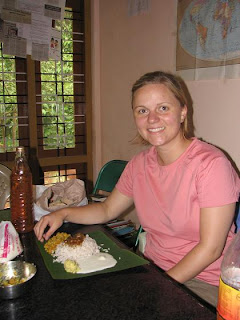My boss’s name is Mr. E. K. Mohanan, we just call him Mohanan. He is a very tiny man, full of energy and has been very gracious in caring for us. He is very concerned for our safety and has made moving in much easier. Mohanan’s English is very usable, if you speak slowly and clearly.
HPWDS moved offices the week before we arrived and they are located a convenient 10 minute walk outside of town. The location is idyllic in the midst of the jungle cover. The office has a very nice working space, and can be very convenient when the electricity it on. We eat lunch at the office with the staff. Yesterday, Mohanan’s wife cooked us a meal that was some of the most delicious food I have had since arriving in India. The food is very spicy here, I usually have to take a break halfway through a meal to let my mouth cool off before I can continue eating—much to the amusement of natives. Meals are served on banana leaves that are plucked from the trees outside. You eat with your hands; rice and everything. It is silly how hard it is to put food into your mouth using your own hands. Babies seem to know how to do it, but I can’t seem to manage it half of the time. I’m getting better at it. Funny to think about our use of utensils and how using our natural endowment of opposable appendages is too “advanced” for us (Americans).
Anywho, work is demanding and engaging. We have had two days at the office so far, which we have spent interviewing the staff regarding the programs. We have just been constructing a detailed picture of HPWDS’s activities so that we can start identifying indicators of success and ultimately structuring the evaluation tool. Regular works hours are only from 10am-5pm, but they work six days a week, not five. The interviewing process has been arduous due to the language barrier and our lack of knowledge about the general social and economic challenges of the area, also about agriculture. I have learned a lot of interesting things in the last two days. We have enough information now to begin work on the tool. Today will be the start of our first week of only seven weeks to complete our work. We have a scheduled week by week plan of what we hope to accomplish and it is quite ambitious, we are constantly trying to stay focused and realistic so that we can truly produce work that HPWDS can use to move forward. If you are curious about more details of the work, I will begin in the next few weeks to write on my webpage so you can check that. I don’t want to bore everyone with social work and planning details.
I will say that there is clearly a status differential that Leigh and I have to try and combat as much as possible. Due to our education, computer skills and nationality we attract a celebrity status that is beyond just our novelty, especially in the office. We are looked upon as the professional experts who hold all the answers—it is a rather uncomfortable feeling. Not so much because I feel under-qualified, the level of guidance they are looking for I actually feel quite qualified to give, but because it is not a healthy organizational attitude to take.
We are finding that HPWDS has a bit of a deficits perspective about themselves and really are looking outside of themselves for the keys that will help their organization go forward. Leigh and I have tried for 1.5 days in multiple ways to illicit a list of the organization’s current perceived strengths, to no avail. We are quite puzzled by the clear wall we are hitting and are left to ponder the conundrum. Are we hitting something cultural where saying positive things about oneself is taboo? If they appear too capable are they concerned we will not offer help? Via a strong vision of what they want in the future have they convinced themselves that they do not have any of the pieces to arrive at that future? What in the world is going on? We cannot get any sort of positive self-assessment of the organization or its programs. I would say that has been the biggest challenge thus far.






















 Our First Monsoon
Our First Monsoon



















